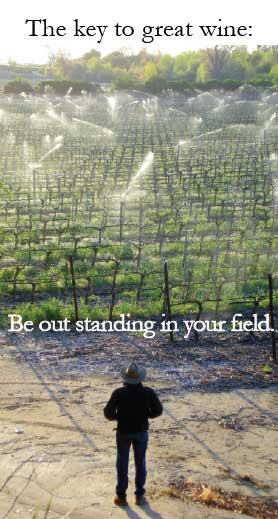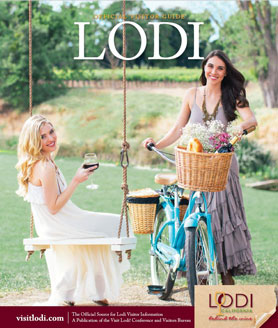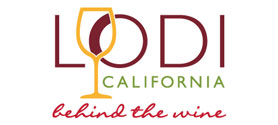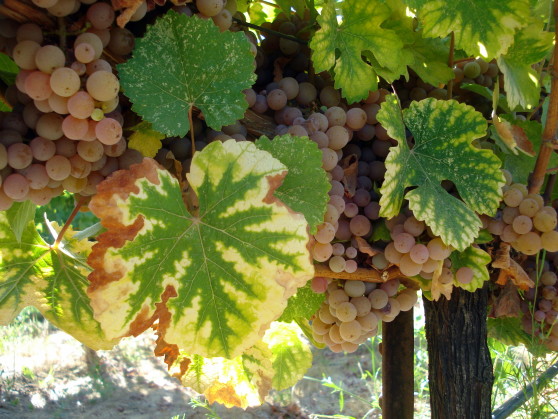
“We’re always listening to all of our loyal fans, and one thing that kept coming up was, ‘When will you have a dessert wine?’” explained Borra’s winemaker, Markus Niggli.
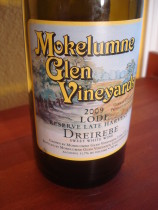 So when fellow winemaker Brett Koth of Lodi’s Mokelumne Glen Vineyards asked if Markus would be interested in collaborating on a German-style sweet white, Markus agreed, but only if Brett brought his years of experience along to supervise the making of this very different wine.
So when fellow winemaker Brett Koth of Lodi’s Mokelumne Glen Vineyards asked if Markus would be interested in collaborating on a German-style sweet white, Markus agreed, but only if Brett brought his years of experience along to supervise the making of this very different wine.
Every year since 2003, Brett’s been bottling this late-harvest white as Mokelumne Glen’s “Dreirebe” – a made-up name translating to the “three varietals” of Rieslaner, Gewürztraminer and other mystery vines. (Those “mystery” grapevines have never been positively identified, though he thinks they may be Weissburgunder, which is also known as Pinot blanc.)
These vines are picked one varietal each per day over three days in late October – about a full month later than they pick their non-dessert versions of the same wines. By then the grapes are hyper-ripe, with sugar readings for the Rieslaner coming in around the mid-to-high 30’s in terms of degrees Brix, while the Gewurz is between the high 20’s and low 30’s.
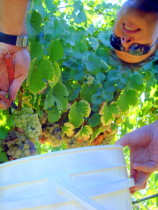 Somewhat unusual for white wines, Brett starts by destemming and crushing the grapes into blue plastic 55-gallon drums that are kept chilled for a cold soak that can bring the Brix up another 1-3 degrees. A bit of sulfur in those cold drums keeps unwanted organisms from changing the purity of character of these grapes, and helps combat oxidation. After several days, the three lots of soaked-up must are finally pressed together and allowed to co-ferment. (Note that most white wines have their grapes pressed immediately upon reaching the winery.)
Somewhat unusual for white wines, Brett starts by destemming and crushing the grapes into blue plastic 55-gallon drums that are kept chilled for a cold soak that can bring the Brix up another 1-3 degrees. A bit of sulfur in those cold drums keeps unwanted organisms from changing the purity of character of these grapes, and helps combat oxidation. After several days, the three lots of soaked-up must are finally pressed together and allowed to co-ferment. (Note that most white wines have their grapes pressed immediately upon reaching the winery.)
Fermentation takes place in one small stainless steel tank set to 55° F over a period of about 10 days. The cold temperature not only holds in otherwise volatile desired aromas, it also makes it easier to stop the working yeasts with a shot of sulfur at the desired sugar level of 12 to 14 degrees Brix. Deep-chilling the tank below 30° F also prevents any yeast from waking up before bottling.
The yeast are then given until the following March to settle out before the delicious nectar is filtered and corked into precious few half-sized, 375mL bottles. (Brett insists on as little winemaking intervention as possible, so that the wine is not fined or heat-stabilized.)
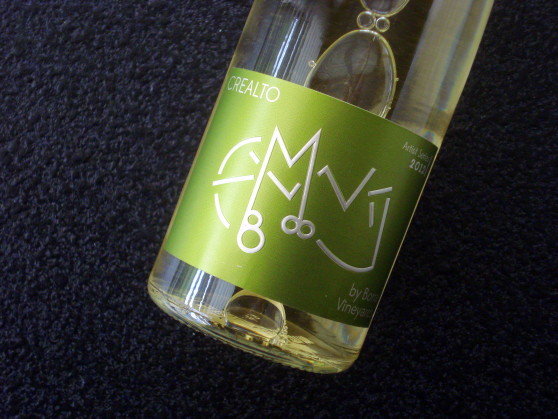
CREATING A NAME
I asked Markus the same question I always ask when I see a new name on one of his labels, “How did you come up with the name ‘Crealto’?” to which he quickly responded, “I have no idea.”
Pressed further for a more-marketable answer, he said, “Crealto was meant to be part of the Artist Series, that is all about the creation of something different. You don’t want to use just plain English for a label. You try to find another word for this joint venture between Brett’s family’s vineyard and the winery.”
And regarding the label artwork, if you look carefully at the labels for all three 2012 wines in the Artist Series, you might just be able to make out a “W8872MKB” – for Weesen and its postal code, where Markus grew up in Switzerland, and for the first letters of the names of Markus and his brothers Konrad and Bernhard.
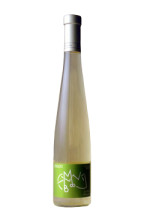 TASTING AND EATING
TASTING AND EATING
If you are a fan of peaches and pears, then you must stop reading and just hit the Add to Cart button (below) right now, because you’ll find loads of those two stone fruits in this straw-colored, concentrated, light syrup nectar. The low 11.4% alcohol makes this mouth-enveloping blend very easy to drink. And what comes across as some fig and a gentle squeeze of orange juice rounds out the complexity and keeps the wine balanced, not cloyingly sweet. Don’t miss inhaling the cold-fermented aromas of honeyed yellow peaches with lingering orange blossom and vineyard dust.
You can practically drink it straight from the half bottle, but if you’re hungry, Brett recommends a peach pie. Markus goes a little more elaborate, “It’s great with dried figs, nuts and Havarti cheese.”
My wife and I stumbled on a leftover chunk of a good friend’s smoked salmon, which made a surprisingly fantastic pairing. The richness of the smoked flavor nicely interplayed with the sweetness of the wine, such that neither dominated. All we needed were a few capers to push it over the edge.
And as for age-ability, Brett says, “We’re still selling our 2009 Mokelumne Glen Dreirebe, and we’ve got one 2005 left. It should age very well, like a Sauternes.”
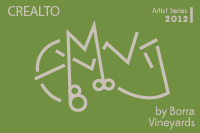
2012 Artist Series Crealto
Lodi Appellation, Proprietary White German Sweet Dessert Wine
Rieslaner, Gewürztraminer and grapes from mystery vines
Our first dessert wine is a team effort by winemakers Markus Niggli and Mokelumne Glen’s Brett Koth. In a departure from standard white-wine winemaking, Rieslaner, Gewürztraminer and grapes from mystery vines all soak on their skins for three days before a 10-day cold fermentation, resulting in loads of peaches and pears in this straw-colored, concentrated, syrup-like nectar. The low 11.4% alcohol makes this mouth-enveloping blend very easy to drink, and what comes across as some fig and a gentle squeeze of orange juice rounds out the complexity and keeps the wine balanced, not cloyingly sweet. Don’t miss inhaling delicate aromas of honeyed yellow peaches with lingering orange blossom and vineyard dust. If you’re hungry, go for a chunk of smoked salmon with capers for a surprisingly super wine interplay. 60 cases produced. (11/05/2013)
Read much more on our blog "Crossing over to the Sweet Side."
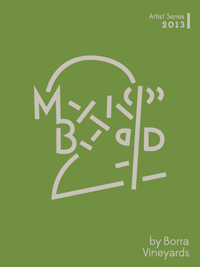
2013 Artist Series Kerner Blend
Lodi Appellation, Proprietary White German Varietal Blend
50% Kerner, 25% Riesling, 25% Bacchus
"Borra now produces the most 'contemporary' style wines grown in Lodi today, period." – Randy Caparoso in his blog
Our winemaker, Markus Niggli, nicknamed this Kerner-based blend “Vinho Verde” after the popular Portuguese style of bottling wine so quickly after crush that not all the natural carbonation has dissipated. This is a no-holds-barred intense shot of pure lime and gorgeous kiwi fruit layered in minerality that is incredibly refreshing. And that carbonation brings a sizzling spritziness that will make your mouth water for Fettuccine Alfredo with Shrimp, Chicken Cordon Bleu, or a decadent Triple Cream Cheese. The lively limes will keep dancing on your tongue for the better part of an hour – no kidding! (Steve Borra calls it “Zipcode” because the label secretly contains the postal code for Markus’s hometown in Switzerland.) 42 cases produced. (03/08/2014)
Read much more on our blog "The Most Contemporary Collaboration."
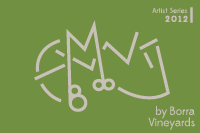
2012 Artist Series Riesling
Lodi Appellation
For those who like a touch of sweetness, our new Riesling offers just the right amount. There is a soft delicacy to the scent – perhaps juicy peach with lime and apple blossoms. What blows us away about this wine is the zingy super long finish of lime and orange that follows unctuous honeysuckle, white peach, oils of citrus and who knows what else. But watch out, you’ll have emptied the half bottle before you figure it all out! 60 cases produced. (4/24/13)
Read much more on our blog "The Most Contemporary Collaboration."
